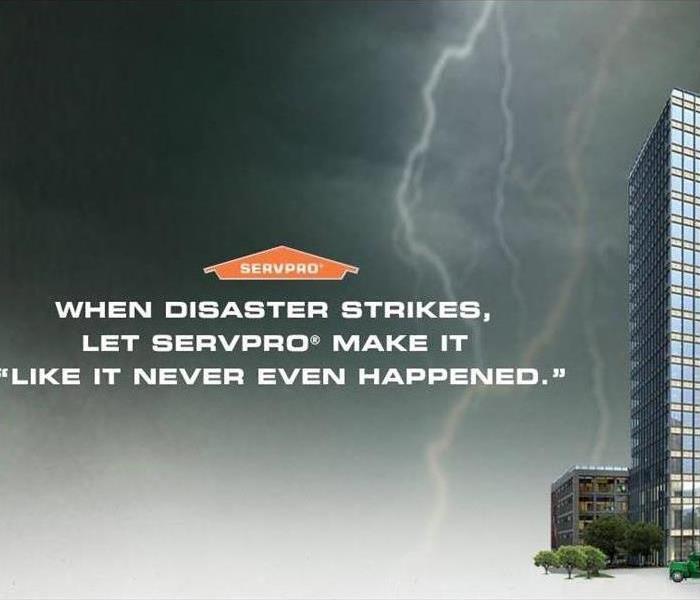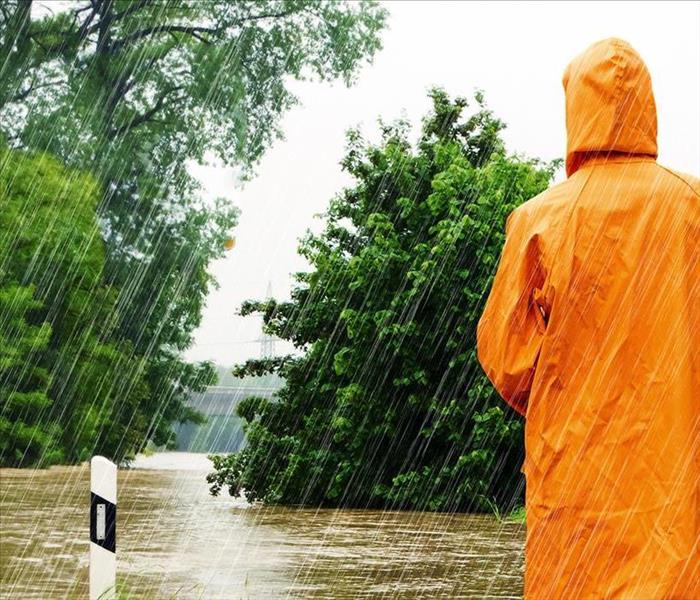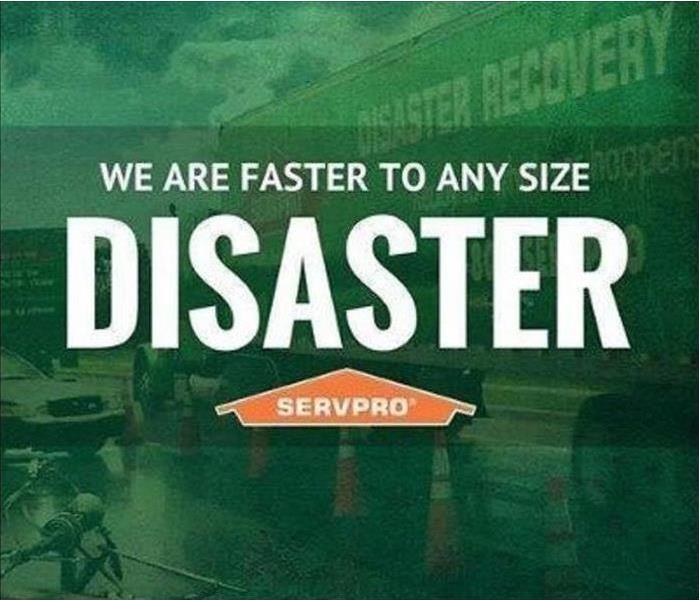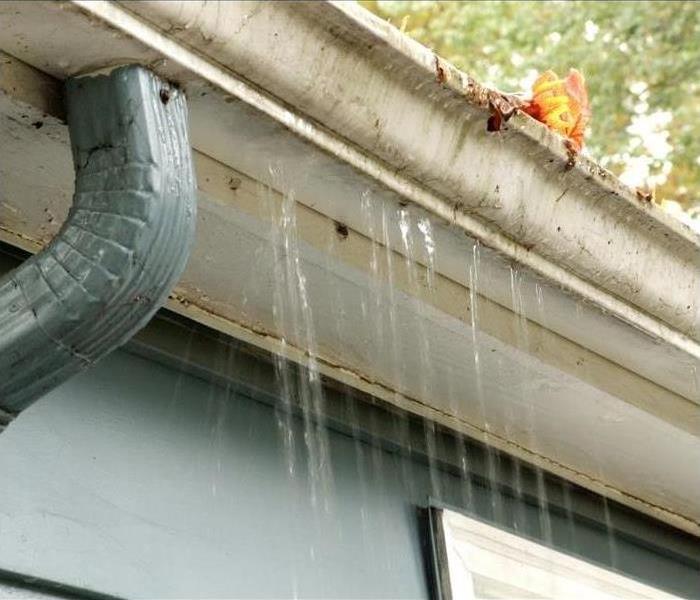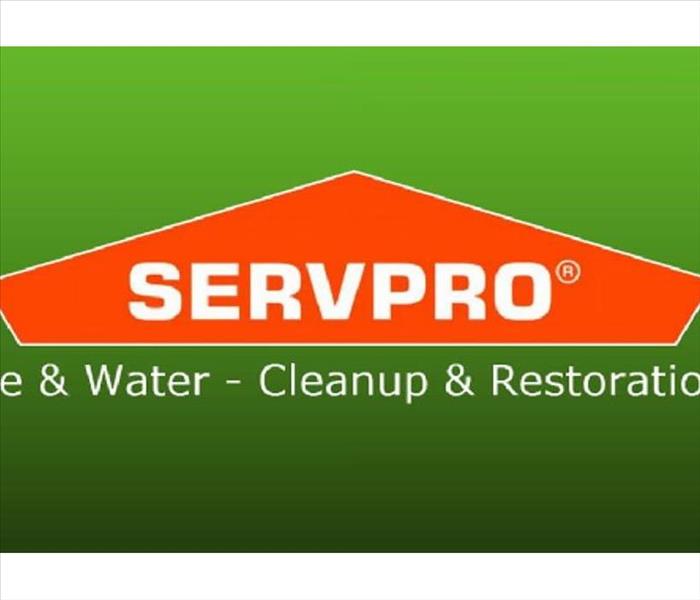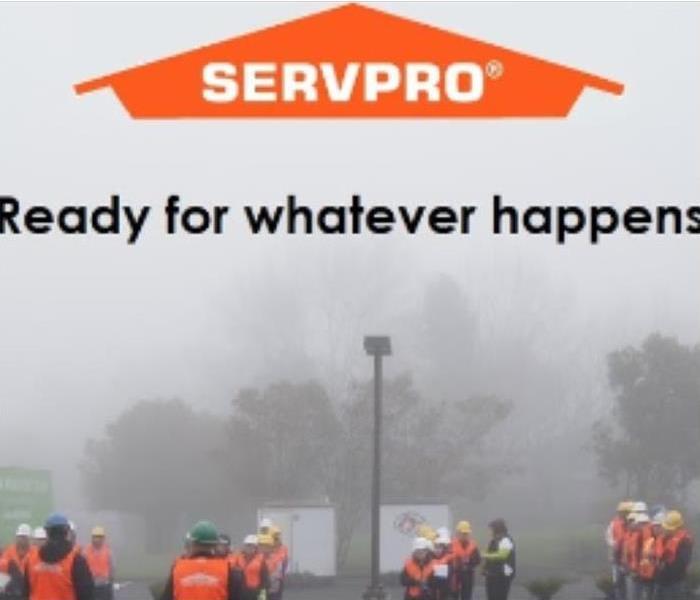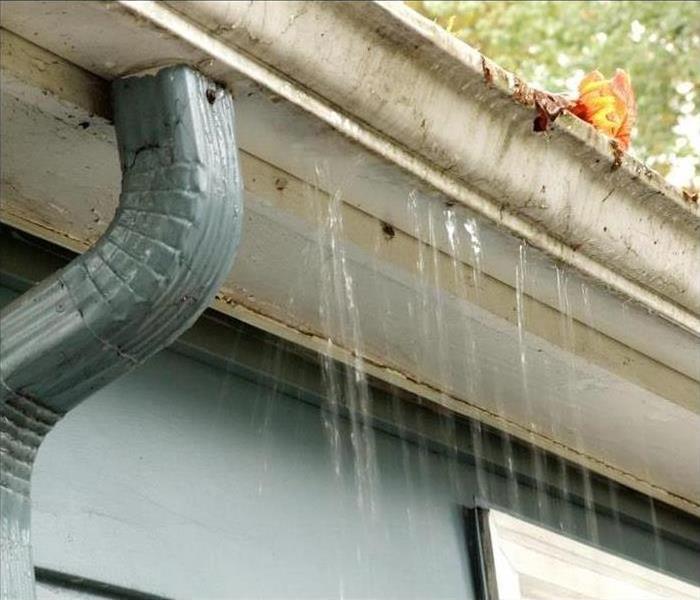Archived Storm Damage Blog Posts
Commercial or Residential Roof Damage: What to do/What Not to Do
8/23/2022 (Permalink)
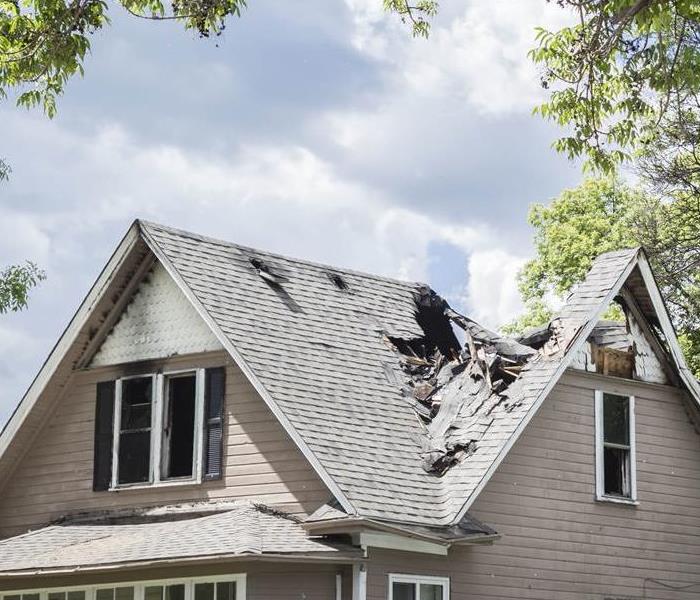 Severe roof damage caused by a storm.
Severe roof damage caused by a storm.
A severe storm may leave your commercial building, your home or property with damaged windows, walls, or a damaged roof. Acting quickly to avoid further damage caused by natural elements or intruders is essential. The first step is to contact your local SERVPRO professionals and experience our rapid commercial or residential response teams.
What should you do in the meantime?
- Above all, safety should be your number one priority. Vacate the premises in the event of major roof damage.
- Stay away from electrical hazards such as electrical lines that may have fallen.
- Contact the utility company to ensure lines are de-energized.
- An initial roof assessment should be done from the ground since damage may not always be visible.
What should you avoid while waiting for help?
- Don't enter rooms where overhead damage may be a safety hazard.
- Do not attempt to install a tarp during a storm.
- Don't climb on a roof. The damage is not always visible.
- Don't walk on tarped surfaces.
- Do not use a metal ladder near power lines or in close proximity to energized electrical equipment.
- Don't attempt to remove debris from the roof
SERVPRO strives to arrive at your property within just one hour of your call. Until we arrive, make sure to keep safety as your main priority when you experience storm damage. Not only we will assist with emergency services we are also equipped to resort your property to pre loss condition and make it "Like it never even happened".
Thunderstorm Preparedness
6/20/2022 (Permalink)
 These things can get pretty messy pretty quickly.
These things can get pretty messy pretty quickly.
Thunderstorms, especially of the summer variety, can be incredibly dangerous for more reasons. Weather conditions can range from the aforementioned rain and thunder to hail, all the way to microbursts. While they are uncommon, it is not unheard of.
In the southland, we tend to get a mix of heavy rain and dry thunderstorms. Below are some great and helpful tips, courtesy of your friends at SERVPRO of Hacienda Heights / Rowland Heights.
Here's what to do before a thunderstorm:
- To begin preparing, you should build an emergency kit and make a family communication plan.
- Remove dead, rotting trees and branches that could fall and cause injury or damage during a severe thunderstorm.
- Put outdoor activities on hold until the weather clears up.
- Secure outdoor objects that could blow away or cause damage.
- Get inside a home, building, or hard-top automobile (not a convertible). Although you may be injured if lightning strikes your car, you are much safer inside a vehicle than outside.
- Remember, rubber-soled shoes and rubber tires provide zero protection from lightning. However, the steel frame of a hard-topped vehicle provides increased protection if you are not touching metal.
- Shutter windows and secure outside doors. If shutters are not available, close window blinds, shades, or curtains.
- Unplug any electronic equipment well before the storm arrives.
SERVPRO of Hacienda Heights / Rowland Heights wants to once again remind you that even though we live in bright and sunny southern California, disaster can strike randomly at any time. If it does, be sure to give us a call first. We have the knowledge and staff to make it "Like it never even happened."
The Dust Rush
6/20/2022 (Permalink)
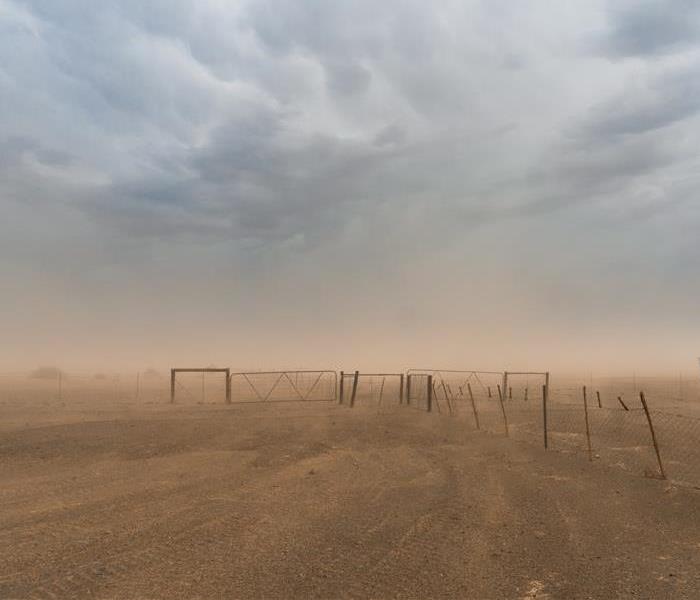 Cover your eyes!
Cover your eyes!
Having lived in California for my entire life, I have seen some crazy stuff in regard to the weather. I've seen dust devils that reached to the heavens and threw full-sized trash cans around like children's toys. I have seen sunny, cloudless days quickly turn into torrential downpours, even including hail and rain the size of golf balls. These events are not common, but I have seen them with my own eyes.
We live in an area that is prone to flash floods. With no warning at all, easily passable roadways can become dangerous torrents of gushing water. This makes mundane things like driving on the freeway incredibly dangerous. Puddles and slick roadways make for very undesirable driving conditions.
These flash floods can also impact your business or your home. With many people working away from home still, there are 8 or more hours of the day where your home is left alone. In that time, there is plenty of opportunity for flash flooding to completely decimate your home.
If you come home to a flooded house, be sure to call SERVPRO of Hacienda Heights / Rowland Heights first. With over a decade of experience in the water mitigation industry, there is no better team to restore your home.
Gone with the Wind
6/17/2022 (Permalink)
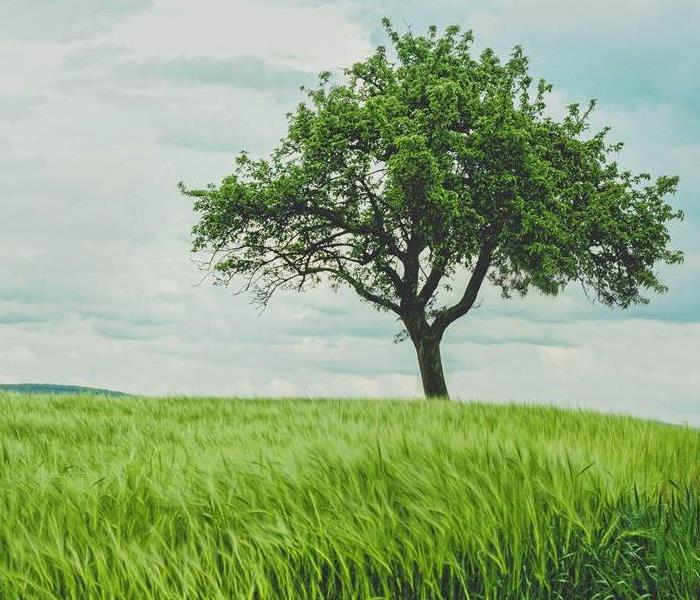 I have my eye on you, pal.
I have my eye on you, pal.
Let's talk about wind for a moment. Sometimes, wind is useful. Windmills are a useful source of energy. Pollutants and other health hazards like smoke can be pushed along and cleared out of an area. Wind isn't always bad, but it can be.
Enter: your sliding glass door. We will call it "Charlie" for this example. You love Charlie. Charlie allows light, fresh air, and yes, even wind into your home. You clean Charlie weekly as a sign of your gratitude. Charlie is an alright guy in your book. One day in late spring, you notice that the weather is acting a bit odd. Random gusts of wind bend and push heavy tree branches above your home. Out of nowhere, one of these branches snaps off and launches a tree branch through Charlie, splintering the glass and allowing whatever critters nature has to offer free entry into your home. Rest in pieces, Charlie.
While the above story is a dramatization, we have seen multiple situations just like it take place. Many homes have glass sliders and windows, and just as many homes have nearby projectiles ready to be launched through said glass. If this happens to you, don't fret: SERVPRO of Hacienda Heights / Rowland Heights is just a phone call away. With over a decade of experience and the knowledge and products necessary to restore your home to preloss conditions, there is simply no better option.
Lightning Crashes
6/17/2022 (Permalink)
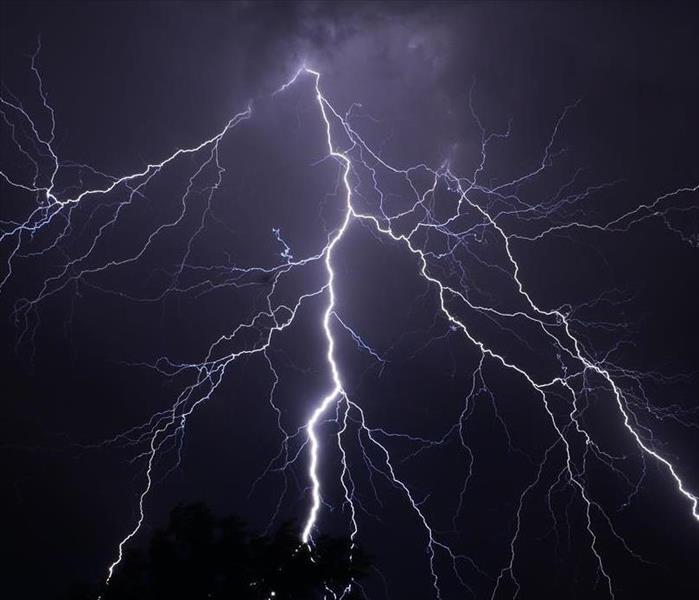 Very cool. Destructive, but cool.
Very cool. Destructive, but cool.
Lightning is cool. Yes, I said it. I enjoy watching the sky light up with dancing energy and pulsing electrons and protons tangling to create a giant flash, especially at night. Thunder is even cooler, especially when it is close. I was terrified of these things as a kid but as an adult, they mystify and captivate me.
Less captivating are the occasional effects of a lightning strike, specifically when they cause damage. Very seldom does thunder do anything but scare house pets, but lightning can create fires and other hazards like downed power lines.
Once in a while, lightning causes housefires. It isn't super common, but it does happen from time to time. This is especially true in particularly wooded areas or properties with a lot of trees. Just like any other ignition source, lightning superheats wood and plastic, causing them to burst into flame. Couple this with summer storms (often bringing little to no rain) and you could have a very sticky situation on your hands.
If your home or business is affected by a lightning strike or fire, give SERVPRO of Hacienda Heights / Rowland Heights a call. Even though the cause of the fire is unique, the end result and subsequent restoration efforts are much the same. We have over a decade of experience in commercial and residential fire restoration and will bring your property back to preloss condition quicker than you can say "one Mississippi".
Passing The Torch
6/2/2022 (Permalink)
 They grow up so fast.
They grow up so fast.
I was recently reminded of the Texas Freeze Event of 2021. Millions lost power, businesses, and homes during the freak series of storms that came ripping through the United States' southern coast. SERVPRO franchises from all across the country were summoned to help do our part in restoring the areas affected.
Big storms like that one are by no means common, but they do happen. When they do, rest assured that SERVPRO of Hacienda Heights / Rowland Heights is prepared to jump into action. Our technicians are IICRC certified, but the training does not stop there. One of the things that makes SERVPRO unique is our continued learning in real time out in the field. When a new technician is brought on, they are paired with one of our expert veterans for an extended period of time to make sure they know the ropes before we ever even consider letting them go out on their own.
Storms bring about a deal of uncertainty, but one thing is for sure: SERVPRO of Hacienda Height / Rowland Heights will be here for you if you need us in the event of one.
How SERVPRO is helping with Hurricane Ida
8/31/2021 (Permalink)
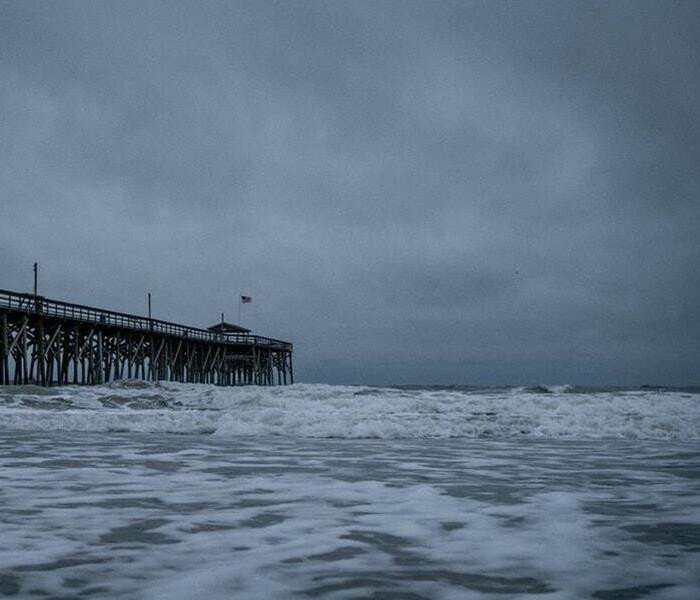 Hurricane season is in full swing.
Hurricane season is in full swing.
The spring and summer of 2021 have proven to be quite destructive in terms of natural disasters.
With northern California, Oregon, and Washington states, respectively, experiencing some of the largest fires on record, the Cayman Islands and the Gulf coast are experiencing a storm that was on track to cause more damage than Hurricane Katrina. Hurricane Ida (later reclassified as a tropical storm) began near the Cayman Islands in the Caribbean Sea. It made landfall on the coastal region of Louisiana on the morning of August 29th. As of the writing of this article, it has caused five deaths and left close to a million people without power.
Our very own Storm Team Wilson has been activated to help the affected communities with their cleanup efforts, and shortly thereafter an open invite was sent to all SERVPRO franchises that could offer support.
Hurricane Ida has since devolved into a tropical depression, but not before causing widespread destruction and millions in damage. New Orleans expects to be without power for weeks and much of the Gulf coast is under a boil water order.
SERVPRO has assisted in many major disasters, including Hurricane Katrina (2005), the Camp and Carr fires, respectively (2018), and the Texas Freeze Event (2021). Thousands of SERVPRO technicians were dispatched to these events to assist in cleanup, dry-out, and fire damage efforts. With guidance from the Storm Teams and assistance from other franchises, SERVPRO has staked our claim as a leading brand in disaster cleanup.
We will keep you updated as this event continues to unfold.
Find The Water Intrusion
6/9/2021 (Permalink)
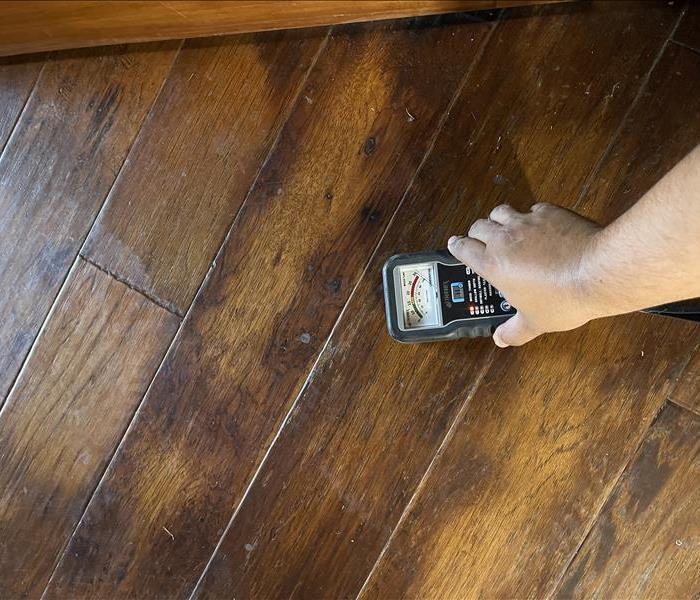 Damaged wooden floor with a moisture reading that's showing high moisture
Damaged wooden floor with a moisture reading that's showing high moisture
When a Storm Hits and you notice water coming into your home or business during the rain find where and how the water is getting in right away. Don't wait to stop the water intrusion. Once found do what ever it take whether the water is entering through your roof, cracks on the exterior, windows or even from the ground it is best to get the source found and fixed right away to prevent further damages. Having the source and fixing it during the current rain fall will ensure you have successfully stopped the source of water intrusion completely.
Waiting to have the source fixed can cause serious damages to your home or business, especially when dealing with water.
SERVPRO can assist in mitigation the water damage to lessen the long term damages it can cause.
We are available for any Emergency Service needs 24/7 Call us today!
Texas Freeze 2021
6/8/2021 (Permalink)
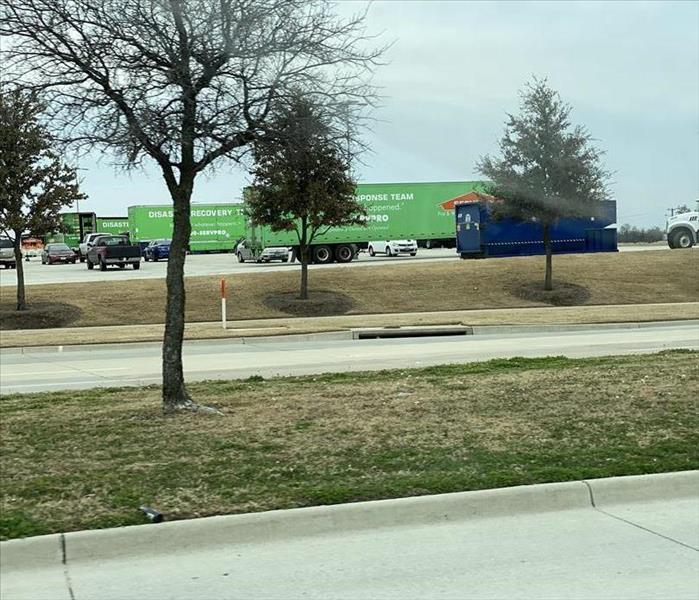 When you see green... we mean business!
When you see green... we mean business!
4 months ago, we SERVPRO were called to assist in Texas during the Winter Freeze 2021. This horrible vortex came in on February 11th our Crews were in the Dallas area by the 15th to assist. We were constantly being called upon homeowners, who's homes had suffered burst pipes from freezing. Our crews were in Texas for almost 2 months, we assisted with water mitigation, and lots of demolition. So, many beautiful homes were damages completely. Many families were without electricity and water for days, weeks.
We were glad to be a part of the SERVPRO team that was able to get so many people help, by getting their homes back to normal.
See below for more information about this horrible Winter Storm that will go into history for the damages it caused:
The Winter Outbreak that occurred on Valentine's Week 2021 brought not only snow, sleet, and freezing rain to Southeast Texas, but also extreme cold temperatures that lasted for several days. This was one of the most impactful winter events in recent history that brought multiday road closures, power outages, loss of heat, broken pipes, and other societal impacts for the region. While the damage is still being assessed, this will likely go down as the first billion dollar disaster of 2021 globally, and potentially the most costly weather disaster for the state of Texas in history, surpassing even Hurricane Harvey from 2017.
There was a total of 8 days, 23 hours, and 23 minutes of winter highlights between the first Winter Weather Advisory issued on Thursday, February 11th at 9:37am to when the last Hard Freeze Warning expired at 9am on Saturday, February 20th.
The winter outbreak in February 2021 will be on the minds of every Texan for a very long time.
Water in your Crawl Space
6/8/2021 (Permalink)
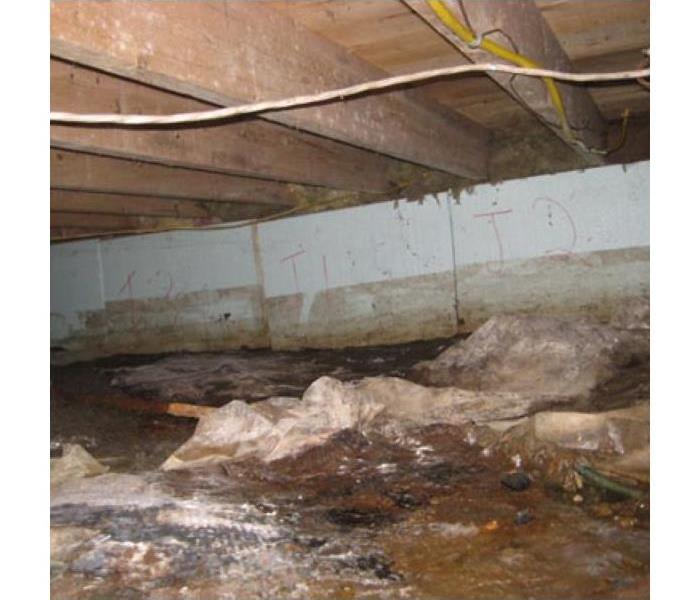 Tip!... don't forget to inspect your crawl space after a storm.
Tip!... don't forget to inspect your crawl space after a storm.
After a storm have you notice an odor or a musty smell through your home, but can't find the cause or damage inside the home? You may have standing water in your crawl space.
Water can get into the crawl space many ways. Usually by a broken pipe lines from under the kitchen or bathroom areas; however, water can also get in crawl spaces from rain and flooding outside depending if your home is on foundation or stilts.
Sometimes we don't realize when we change the outside landscape in the front or back yards that water can then be accidentally deferred into the crawl space. Not knowing there's standing water for a long period of time can then produce an odor or a musty smell and other damages. *keep garden beds away from the home.
During the rainy days it's best to check your crawl space to make sure no water is building up.
Call us today for a free crawl space inspection!
How to Protect Your Home from a Flood
6/4/2021 (Permalink)
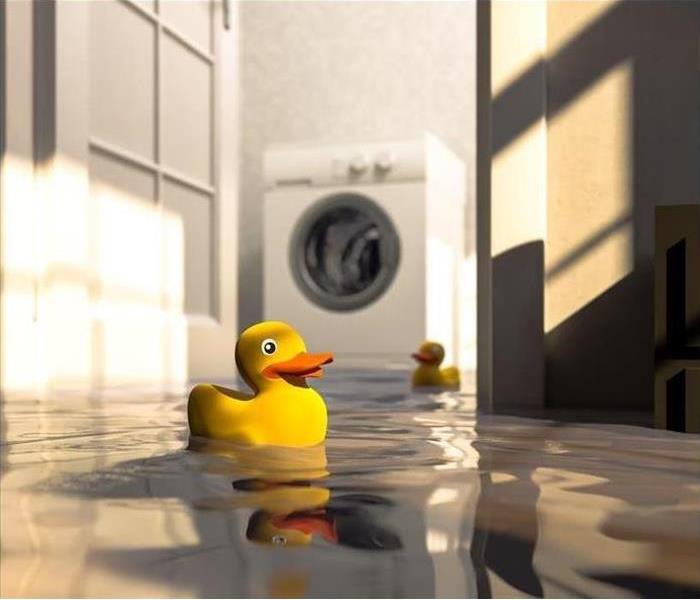 We are here to help!
We are here to help!
It is always an overwhelming experience dealing with floods and other natural disasters. Aside from the loss of valuable properties that comes with the disastrous event, it leaves you much work. As you may have known, it takes much effort to bring back the water-damaged property to its pre-damage condition. Not only is it extra work its also a very stressful moment.
After flooding, mold comes in and begins to grow. In this instance, you will have to cope with horrible odors that may pose health effects in your household. Can you imagine how devastating that feels? It can, of course, get out of hand. That's why we are here to help you from beginning until its "Like it never even happened."
In light of the preceding, you will agree that the effects of flooding on homes are better imagined than experienced. Hence, it’s best to protect your home from flooding than looking for solutions after it has happened. Without a doubt, you will save yourself a lot of unnecessary expenses, having taken some preventive and protective measures ahead.
Now, how can you protect your home from floods? It’s simple. Call SERVPRO a professional restoration service company, we have prepared a simple guide to protect your home from floods.
Pro Tips for Home Flood Preparation
1. The first step to protect your home from a flood is to have flood details of your area. To be on the safer side, know how likely your home will experience a surge in your area. Also, invite building professionals to inspect your home to determine how well it can withstand floods.
2. Ensure that you close every foundation crack with solid mortar, masonry caulk, or hydraulic cement. Hydraulic cement expands and fills gaps adequately.
3. Get battery-powered sump pumps. Sumps pumps enable you to remove excess water from your home when floods come.
4. Install septic or sewer link check valves that allow waste to flow one way. That will prevent sewage from coming back into the stagnant water in your home.
5. Ensure that you keep your expensive and valuable properties in a safe location. That may include furniture, artworks, certificates, and more.
6. Ensure you get an insurance policy that covers cleanup or flood damage repair.
How to Prepare before a Hurricane Hits
6/2/2021 (Permalink)
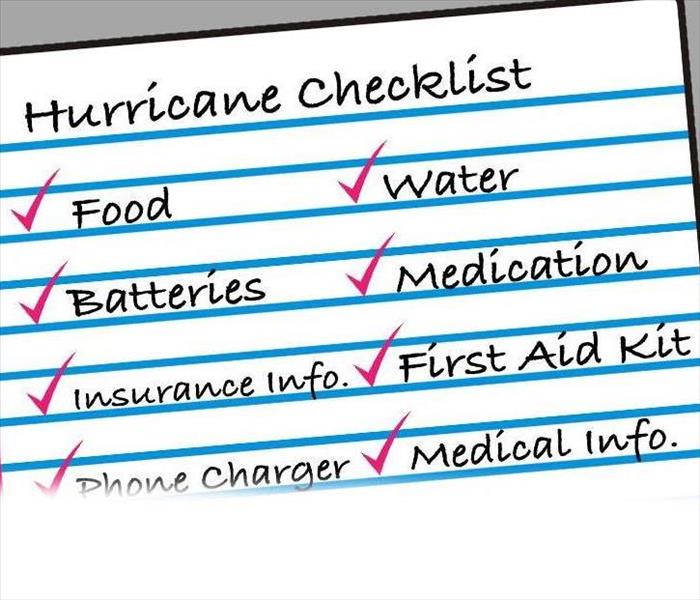 Hurricane Season 2021
Hurricane Season 2021
With June 1st being the beginning of the Hurrican Season 2021 for our neighbors on the East Coast/Atlantic Ocean. Here are a few tips on how to prepare for this years Hurricane Season.There are several things you can do to prepare for a hurricane to lessen the property damage that may occur.
- To prevent windows from breaking, board them up by securing plywood over them or installing permanent storm shutters.
- You can reduce damage to your roof by fashioning straps from the roof to the structure of your home.
- Clear gutters from debris that may clog downspouts and aid in flooding.
- Secure boats and other water vehicles.
- Elevate basement items in case flooding does occur those items won't get ruined.
- Fill your vehicles up with fuel and keep a spare gas tank filled and accessible.
- Construct an emergency survival kit with enough supplies to last at least three days.
These are all recommendations from the Federal Emergency Management Agency (FEMA). If you need assistance keep your local SERVPRO's phone number on hand they can assist when needed.
Hurricane Season 2021
6/1/2021 (Permalink)
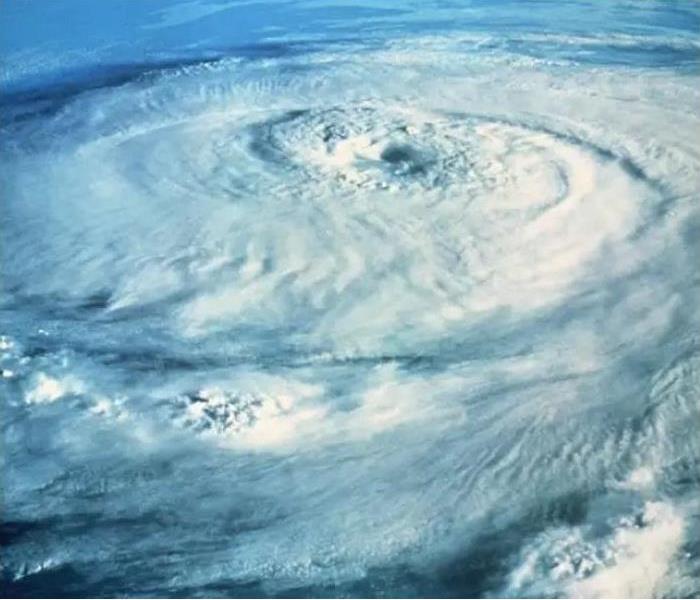 Hurricane from a birds-eye view
Hurricane from a birds-eye view
What is "Hurricane Season"?
June 1st marks the beginning of Hurricane Season in The Atlantic Ocean and it goes until November 30th. The Atlantic Ocean includes the Caribbean Sea as well as the Gulf of Mexico waters.
Hurricanes are considered the most violent storms on Earth. They produce very strong winds, storm surge flooding and heavy rainfall that leads to inland flooding.
Hurricanes form under low-pressure systems over tropical or subtropical waters. They gain their energy from how warm the ocean water is.
Once the hurricane forms, the surface winds cause it to continuously move in circular motion. This type of rotation is often referred to as the "eye".
The "Eye" is the calm, clear center of the storm. The area surrounded by the "eye" is where the winds are the strongest. Hurricanes pack a punch by having winds 74mph or greater.
If you live in a Hurricane prone area, its best to be aware of any hurricanes that might impact the area you live in. Its recommended to be prepared at all times.
Dealing with Storm Damage
6/1/2021 (Permalink)
Dealing with wind or water damage to your home caused by hurricanes, tornadoes, or other severe storms can be both difficult and dangerous. Here are some tips on how keep you and your family safe and begin to get your life back together after the storm hits.
Staying Safe After a Storm
- Listen to the radio for advisories and other instructions.
- Do not venture outside until it has been declared safe to do so.
- Stay away from downed power lines and avoid standing water or metal objects near downed wires.
- Leave and do not enter buildings that have sustained structural damage.
- Stay away from damaged trees and dangling or broken limbs.
- Check on neighbors, especially those who are elderly or disabled.
- Turn the gas off at the meter if you smell gas.
- Do not drive unless absolutely necessary.
- Do not attempt to drive through flooded streets or bridges.
- Avoid using candles or other open flames indoors.
- Make sure your sewer system is working before flushing toilets.
- Operate generators outdoors in the open away from windows and doors.
Cleaning Up After a Storm
- Be very careful climbing ladders or working on roofs.
- Use extreme caution if using a chainsaw to cut trees or branches.
- Cover leaking roofs before the next rain to prevent further water damage.
- Remove wet rugs and carpet from floors.
- Open windows and run fans if you have water damage inside your home.
Dealing with Insurance Companies After a Storm
- Document damage to your home before clean up with photos or video, and compile a written list of damaged items.
- Read your homeowner insurance policy thoroughly to see what is and isn’t covered before contacting the insurance company.
If you'd like more information on our we can help, don't hesitate calling us. We are available 24/7 for Emergency Services
if a Storm of Flood hits, SERVPRO is here to help!
7/8/2020 (Permalink)
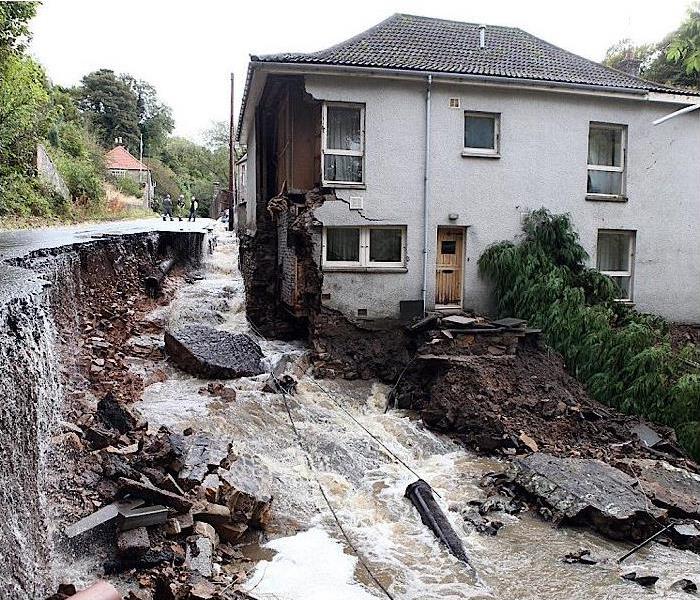 Flood damage caused by a Storm
Flood damage caused by a Storm
SERVPRO of Hacienda Heights/Rowland Heights specializes in storm and flood damage restoration. Our crews are highly trained and we use specialized equipment to restore your property to its pre-storm condition.
Faster Response
Since we are locally owned and operated, we are able to respond quicker with the right resources, which is extremely important. A fast response lessens the damage, limits further damage and reduces the restoration cost.
Resources or Handle Floods and Storms
If storms hits Walnut, we can scale our resources to handle a large storm or flooding disaster. We can access equipment and personnel from a network of 1,650 Franchises across the country and elite Disaster Recovery Teams that are strategically located throughout the United States.
Have Storm or Flood Damage? Call Us Today at (626) 964-7700
Are you prepared for a flood?
7/1/2020 (Permalink)
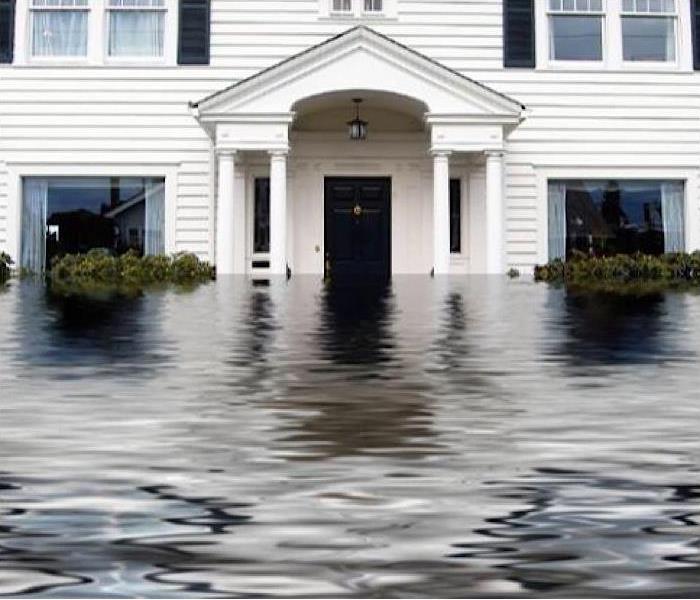 Home Flooded
Home Flooded
Flooding can happen fast in many environments. The American Red Cross recommends having the following list of items packed and ready to go in the event of an evacuation due to flooding.
- Water—3+ day supply; one gallon per person per day
- Food—3+ day supply of nonperishable, easy-to-prepare food
- Flashlight
- Battery-powered or hand-crank radio (NOAA Weather Radio, if possible)
- Extra batteries
- First Aid kit
- Medications (7-day supply) and medical items (hearing aids with extra batteries, glasses, contact lenses, syringes, cane)
- Multi-purpose tool
- Sanitation/personal hygiene items
- Copies of personal documents (medication list and pertinent medical information, deed/lease to home, birth certificates, insurance policies)
- Cell phone with chargers
- Family and emergency contact information
- Extra cash
- Emergency blanket
- Map(s) of the area
- Baby supplies (bottles, formula, baby food, diapers)
- Pet supplies (collar, leash, ID, food, carrier, bowl)
- Tools/supplies for securing your home
- Extra set of car keys and house keys
- Extra clothing, hat and sturdy shoes
- Rain gear
- Insect repellent and sunscreen
- Camera for photos of damage
If your home has suffered a flood keep in mind SERVPRO of Walnut is available 24/7 for you Emergency Service needs!
Common Water Issues for Business Owners
6/10/2020 (Permalink)
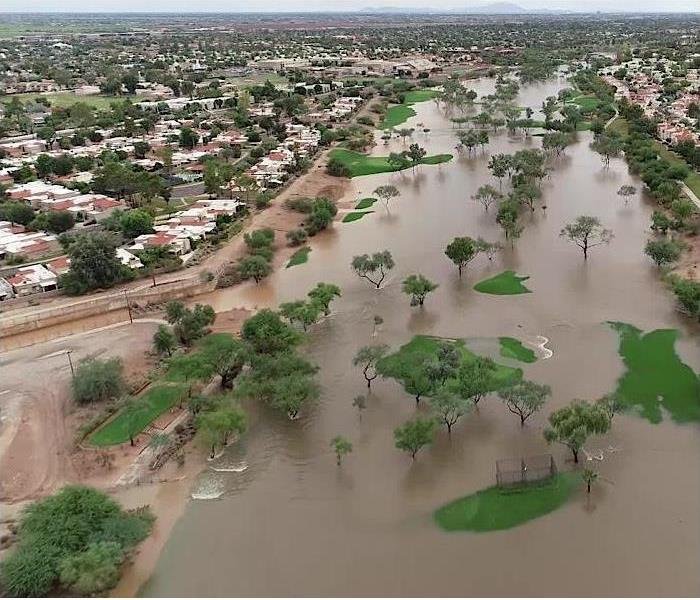 Flood
Flood
For a commercial property owner in Los Angeles County, unexpected water problems can be a big issue. Fortunately, a water damage professional can help you assess, clean, and repair damages from any flooding or leaks you may have. Here are a few of the most common water problems a business may face from leaking pipes to foundation cracks.
1. Pipe Breaks
A pipe break can occur in a number of ways. Over time, the pipe can age and loosen in its fittings, or extensive use can lead to pinhole leaks. Extreme heat or cold can also affect a pipe’s integrity. A blocked pipe can lead to pressure buildup and eventually burst.
2. Plumbing Backup
Blocked plumbing can even lead to a toilet backup or sink overflow. When a pipe is blocked, water can take the shortest path out regardless of its intended flow path. Blockages can occur from a number of things, including the buildup of water minerals over time inside a pipe or someone pouring a solidifying material, such as plaster or grease, down a drain.
3. Weather
Extreme weather conditions can also lead to leaking pipes. Cold temperatures can cause the water in pipes to freeze and expand. The expansion puts pressure on the pipe and can create a crack or even cause it to burst altogether. If you know cold weather is coming, you can check with a local professional about what preventive measures to take.
4. Foundation Cracks
Foundation cracks can also become a problem leading to water damage. Water can seep through any cracks and pool, leading to further issues such as mold. Any cracks should be investigated and assessed as soon as possible to determine the best course of action.
Water damage can happen to a commercial property. Fortunately, a professional can fix the damage caused by leaking pipes, foundation cracks, backed up toilet, or weather, and help you repair your property.
Different Types of Storms
6/9/2020 (Permalink)
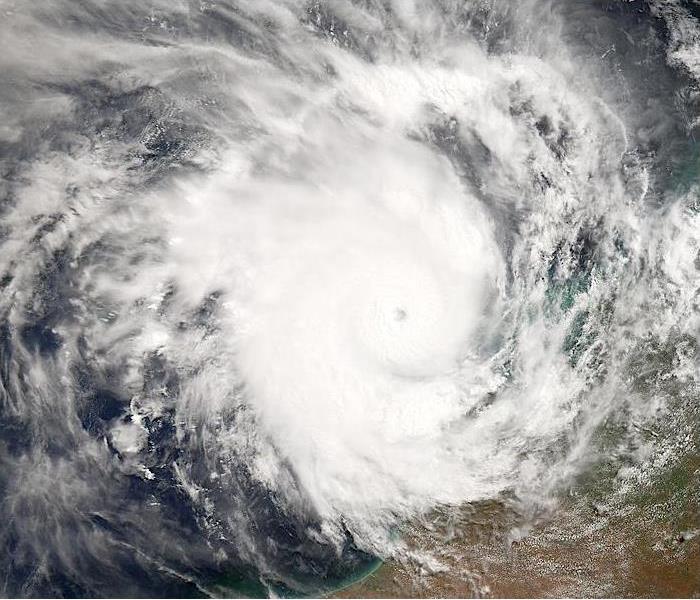 Hurricane in the Atlantic Ocean
Hurricane in the Atlantic Ocean
Here are some of the most common storms that we experience in the United States
1. Hurricanes
A hurricane, also known as tropical cyclones, are large, swirling storms. They are usually caused by rain clouds are building up over warm waters.
2. Thunderstorms
Thunderstorms are storms consisting of lightning and thunder. They are usually produced by a cumulonimbus cloud. This cloud usually produces gusty winds, heavy rain and sometimes hail.
3. Tornadoes
If you live in the central of United States, you are more likely to experience a tornado in your lifetime. These deadly storms are caused by dry cold air moving south (usually from Canada) meeting with warm moist air. This air is traveling north from the Gulf of Mexico. When the two airs collide, they create instability in the atmosphere.
4. Snowstorms
Snow storms are usually caused by moist are rising from low pressure ares. Since these low pressured areas are surrounded and circulating them, it can causes blizzards to rise.
5. Floods
Floods are usually the aftermath of several natural disasters such as heavy rainfall, high tides, tsunamis and hurricanes.
Remember SERVPRO of Hacienda Heights/Rowland Heights is here to help with any type of Water Damage to your home or business (626) 964-7700
Be prepared for the next storm
6/9/2020 (Permalink)
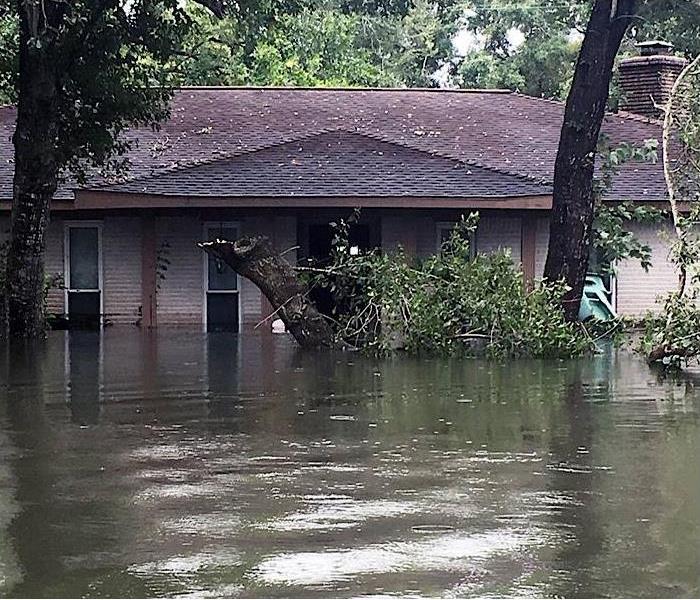 Home Flooded due to Storm
Home Flooded due to Storm
Be Prepared:
Tips from FEMA for preparing your home or business for a flood.
Before the Flood:
- Have a qualified professional elevate the furnace, water heater and electrical panel if susceptible to flooding.
- Installing "check valves" in sewer traps to prevent flood water from backing up into the drains of your home or business.
- Seal walls in basement with waterproofing compounds to help avoid seepage.
During the Flood:
- Turn off utilities at the main switches of valves if instructed to do so.
- Disconnect electrical appliances.
- Do not touch electrical equipment if you are wet or standing in water
- Do not walk through moving water. Even six inches of moving water can make you fall.
After the Flood:
- Listen for news reports to learn if the community's water supply is safe to drink.
- Avoid floodwaters. Water may be contaminated by oil, gasoline or raw sewage. Water may also be electrically charged.
- Stay out of any building if it is surrounded by floodwaters.
- Return home only when authorities indicate it is safe.
Have Storm or Flood Damage? Call Us Today 626-964-7700
Disaster Recovery Team
6/5/2020 (Permalink)
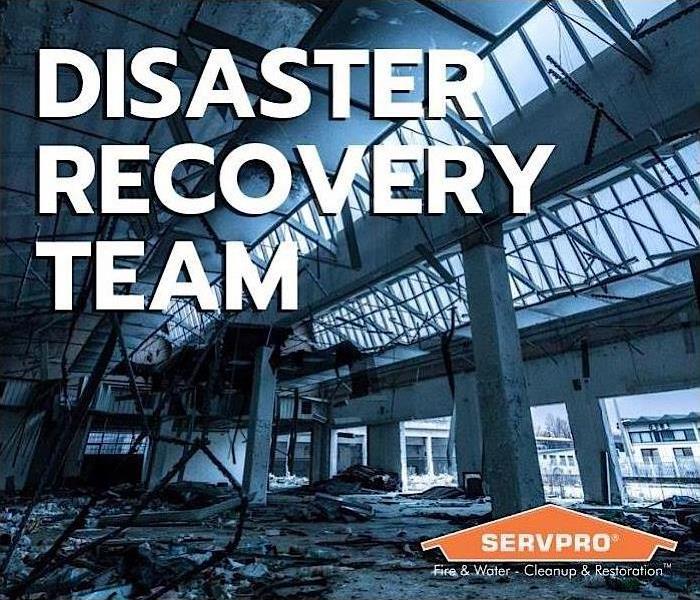 Disaster Recovery Team
Disaster Recovery Team
The SERVPRO Disaster Recovery Team is here to help! Whether you are dealing with a tornado, hurricane, blizzard, flood or major fire the SERVPRO Team is comprised of a giant network of strategically positioned storm teams, who are on standby 24/7, 365, should a disaster strike near you. Making sure to be ‘Faster to Any Size Disaster!’
With the ability to mobilize local command centers, along with the resources of more than 1,700 Franchises across North America, no disaster is too big or too much.
SERVPRO of Hacienda Heights/Rowland Heights has a disaster recovery team transport truck packed with equipment and gear that allows us to be ready to attack whenever and whatever mother nature throws at you. With our crew of highly trained and skilled professionals, natural disasters are no match for us.
We are proud to do business with honesty, respect and unparalleled expertise. SERVPRO of Hacienda Heights/Rowland Heights will make your disaster "Like it never even happened."
Hurricane Season on the Atlantic Coast
6/5/2020 (Permalink)
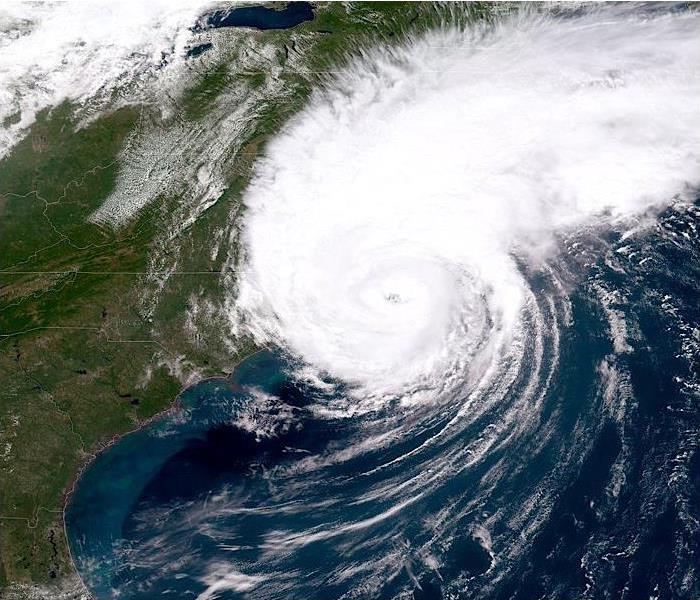 Hurricane on the East Coast
Hurricane on the East Coast
Here are some things that you can still do to limit the damage that your home can sustain from the looming storm that comes with Hurricane Season in the Atlantic Ocean. Us in California on the West Coast don’t see much of this happening. But here are a few tips for our East Coast friends.
If you have resided in the coastal areas for many years now, you are likely already familiar with boarding up your windows if you do not have accordion shutters and similar approaches to prevent the conditions from getting worse while your house weathers the impending hurricane.
Another thing that you should consider as you set to face any Hurricane in your area is to consider this is one of the worst storms that the area has seen for a long time. Tropical storms and severe weather systems might not be newsworthy through the average hurricane season; the Carolina coast government agencies are mandating that residents evacuate coastal counties in preparation for destructive forces. Seek a safe place to wait out the effects of the storm for you and your loved ones. Personal safety is of paramount importance.
Our SERVPRO team of professionals can help you to overcome any of the damages that your home might sustain during this severe event, and our emergency response team is available 24/7 to respond to the situation. As you return to your home when the situation is safer, our team of dedicated professionals can help you to assess the full scope of this damage and mitigate the situation from getting worse. This means pumping out standing water, moving and trying to preserve furnishings and possessions, drying out with dehumidification and sanitizing your home.
While you cannot avoid in many cases the kind of destructive damages that a hurricane of this size can produce in the area, you can rest assured that the right measures can get taken after the storm passes to clean up the mess and restore your property. Give our experienced SERVPRO of Walnut, Hacienda Heights/Rowland Heights emergency response team a call anytime at (909) 598-8400 and we can guide you to the closest SERVPRO on the Eastern side.
When a Storm or Flood hits Hacienda Heights/Rowland Heights SERVPRO is here to help!
6/1/2020 (Permalink)
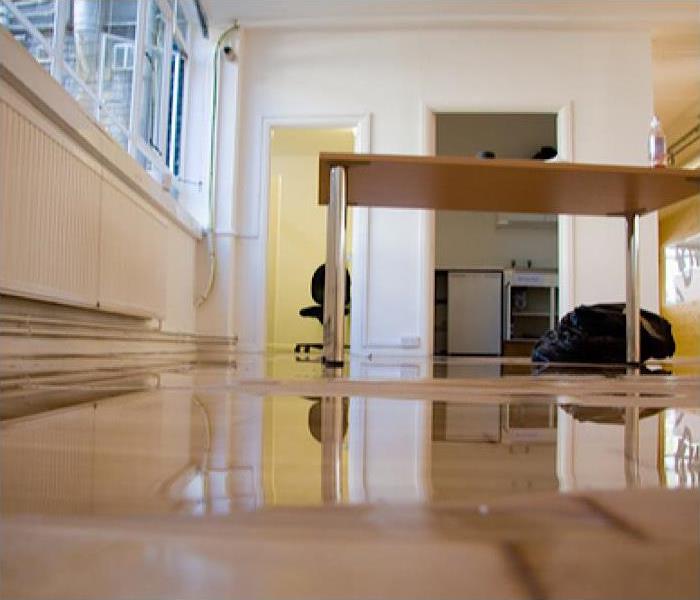 Home flooded
Home flooded
SERVPRO of Hacienda Heights/Rowland Heights specializes in storm and flood damage restoration. Our crews are highly trained and we use specialized equipment to restore your property to its pre-storm condition.
Faster Response
Since we are locally owned and operated, we are able to respond quicker with the right resources, which is extremely important. A fast response lessens the damage, limits further damage, and reduces the restoration cost.
Resources to Handle Floods and Storms
When storms hit Hacienda Heights or Rowland Heights, we can scale our resources to handle a large storm or flooding disaster. We can access equipment and personnel from a network of 1,650 Franchises across the country and elite Disaster Recovery Teams that are strategically located throughout the United States.
Have Storm or Flood Damage? Call Us Today 626-964-7700
Dealing with Storm Damage
6/1/2020 (Permalink)
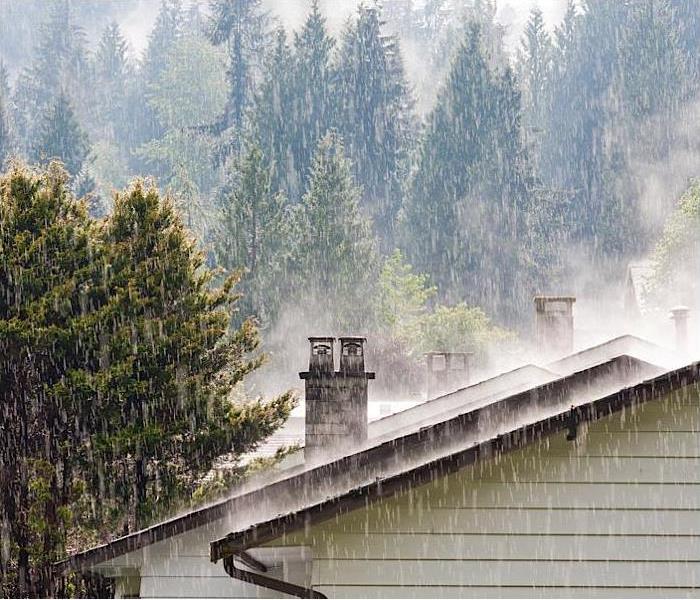 Water damage caused by a storm
Water damage caused by a storm
June 1st marks the beginning of Hurricane Season on the Atlantic Ocean. These reminders should help you and your family prepare for the next one that comes your way.
Water Preparation
A traditional standing water heater holds up to 40 gallons of clean water. If the water to your home isn’t flowing this is a amazing last resort. However, if there's water going into the home, make sure you check with county sites to find out if you are under a boil water alert or not. Make sure you have 1 gallon of water per person for up to one week stored before the storm hits.
Food Preparation
Canned food and none perishable foods like beans, canned vegetables, and soups are amazing to have around. If you have a small gas cooking device you’ll want to empty out your freezer as fast as possible of any frozen foods so make sure to cook through your perishable foods before your canned foods.
Gas/Fuel
Make sure you have a full tank of gasoline in all of your vehicles. Fuel might become limited during an emergency situation. So you’ll want to make sure you are topped off before the storm hits. As for fuel oil this goes for gasoline for generators, propane for cooking, and lamp oil if you plan to use gas lamps for a lightning source.
Outside of these basic items there are an assortment of other items you'll want to keep handy such as:
- hand cranking can opener
- First aid kit
- Cooler for perishable foods
- duct tape and garbage bags
- Flashlight and batteries
This short list of items can keep you prepared for the aftermath of an emergency. It’s recommended each year you check off an emergency disaster check-list to insure your stocks are full before a disaster happens.
Give SERVPRO of Hacienda Heights/Rowland Heights a call when you need help when preparing or dealing with storm damage! (626) 964-7700
How to Predict a Hurricane
7/16/2019 (Permalink)
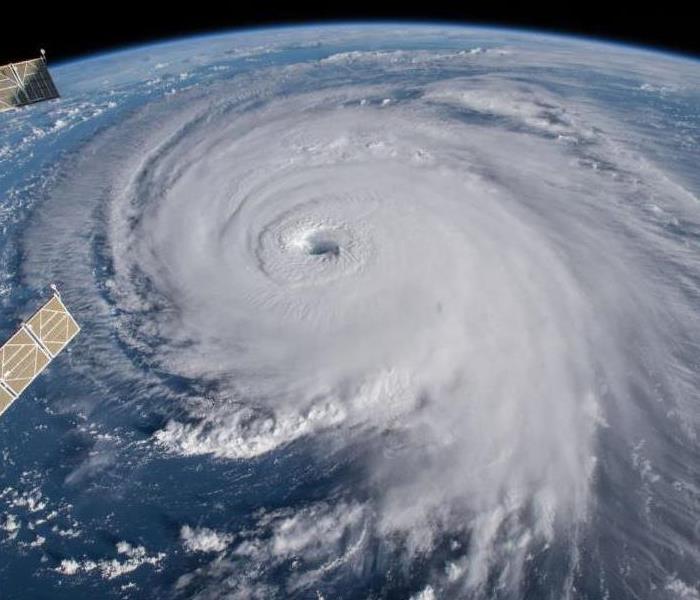 These tips can help you predict a hurricane.
These tips can help you predict a hurricane.
Hurricane predictions can be classified as two different categories. One, Seasonal probabilities and two, the track of a current hurricane. These two categories are completely different and use different methods and approaches.
NASA states the following about tracking hurricanes, “The forecast of a hurricane's path is dependent upon the accuracy of the predicted winds from computer forecast models. The speed and direction of steering winds generally vary with altitude. Weak tropical cyclones tend to be steered more by lower-level winds, while upper-level winds usually influence the paths of stronger hurricanes.”
Where do they form? Hurricanes form over the Atlantic Ocean or eastern Pacific Ocean. They only form over warm waters near the equator.
There’s no need to predict a hurricane on your own. Your local weather news station will warn locals about an upcoming hurricane so that you can time to prepare and evacuate.
What qualifies as a Storm?
7/15/2019 (Permalink)
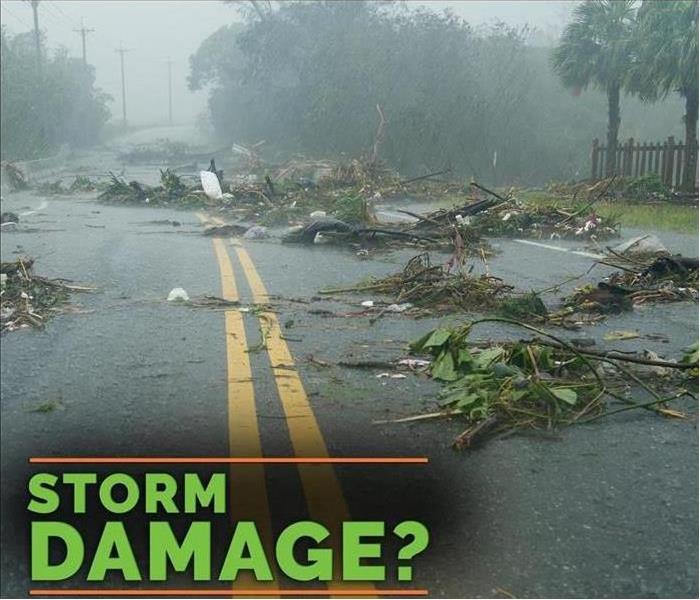 Know the different types of storms to be aware of.
Know the different types of storms to be aware of.
First, what defines a storm? : Wikipedia states, “A storm is any disturbed state of an environment or in an astronomical body's atmosphere especially affecting its surface, and strongly implying severe weather.”
What qualifies as a storm?
- Derecho Storm- This type of storm is unpredictable but usually occurs between June and July in warm weather. It’s a large series of storms that come one after another over a path of at leat 240 miles with the wind speed of at least 58 mph.
- Flooding- Floods often cause massive destruction, ruining the homes of families and businesses. They occur due to rain and fast rising water that is too much for drains to handle.
- Hail Storms- These storms cause damage to roofs, windows, property damage, vehicle damage, and much more. They occur when water in the clouds becomes so cold that it freezes and turns to ice. Only when the ice becomes too heavy is when it falls to the ground as what we know as hail.
- Snow Storms- These storms can be very destructive. When snow lands on top of roofs or buildings, it can be so heavy that it causes roof damage or even collapse a roof. They can also block drains which then causes flooding.
- Hurricanes- Ones that reach land can be extremely destructive. They are the most powerful type of cyclone and they are identified as “low pressure systems, high winds, heavy rainfall and storm surges and swells” says RJI Professionals.
- Ice Storms- These types of storms make freezing rain which covers everything in ice and can be dangerous to vehicles driving on the ice.
- Lightning- Lighting is a big factor in causing falling trees, wildfires, property fires, and even power outages.
- Thunder storms- These types of storms cause excessive weather conditions such as hail, tornadoes, and flooding causing damage to the land around it.
- Tornadoes- This storm is extremely dangerous. With winds traveling up to 300mph, it can uproot homes from the ground and toss them across the land.
- Tropical storms- These storms are classified as a tropical storm only when the wind blows at around 39-73 mph and are prevalent in the pacific and Atlantic. These storms can create damage done by water and debris picked up from the wind.
How to Tell if a Storm is Coming
7/6/2019 (Permalink)
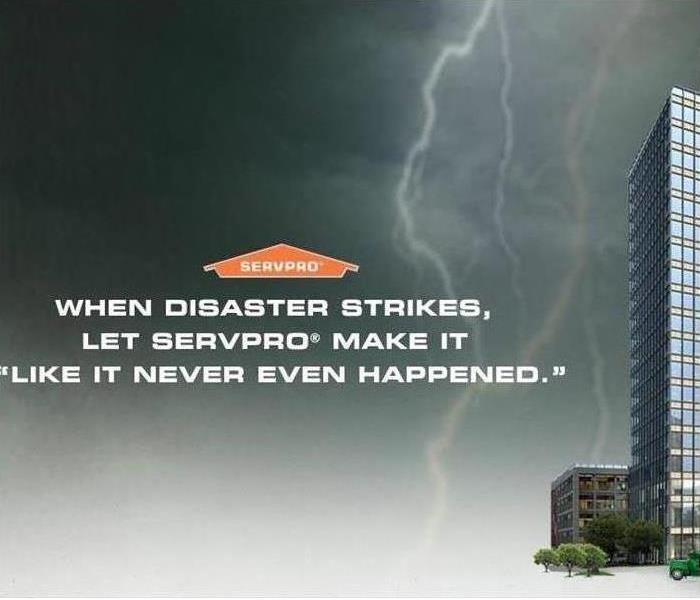 SERVPRO of Hacienda Heights/Rowland Heights is here to help you restore damage.
SERVPRO of Hacienda Heights/Rowland Heights is here to help you restore damage.
If one is, you should always be prepared. Although violent storms can strike anytime, the spring and summer months typically mark an increase in the threat of sudden, severe storms that sometimes include wind, rain, lighting and even hail.
Authorities issue a storm 'watch' when the potential for severe weather exists. A storm 'warning' will be issued when danger from a severe storm is imminent. The following tips will help prepare you to better protect yourself and your property when a storm is on the horizon.
- Put a communication plan in place and prepare an emergency supply kit, including a battery-powered NOAA weather radio.
- Postpone outdoor activities; secure outdoor objects that could become airborne.
- Don't use corded phones or any appliances that are "plugged in." Use cell or cordless phones instead.
- Seek shelter in a home, building or hard top automobile. The steel frame of a vehicle (not the rubber ties) can help protect you from a lightning strike if you avoid touching metal or other conductive surfaces.
- Avoid windows and doors, don't lie on concrete walls, and stay off of porches.
- If you are outside when a storm hits, quickly seek shelter in a sturdy building. Avoid small, isolated structures in open areas and steer clear of hilltops, open fields, the beach or a boat on the water.
After A Storm
- Avoid storm-damaged areas. Stay away from downed power lines and never try to drive through a flooded roadway.
- Replenish your emergency supplies and repair property damage promptly, before the next storm strikes.
Tips on How to be Safe During a Flood
6/13/2019 (Permalink)
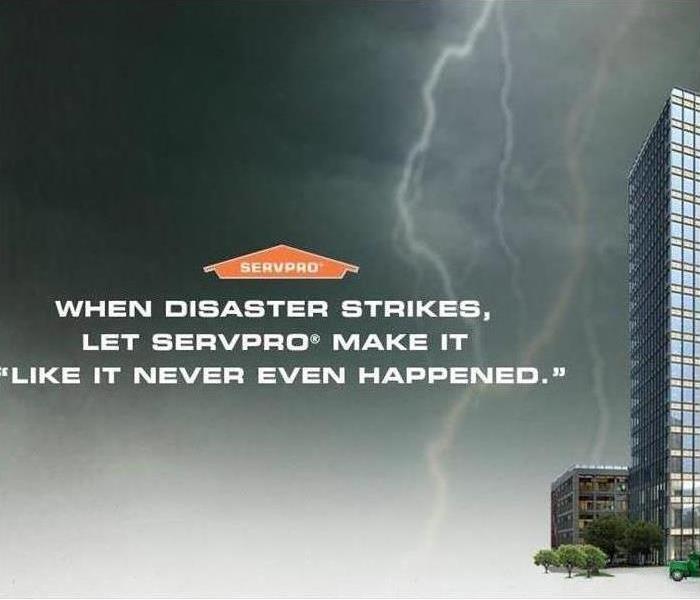 SERVPRO of Hacienda Heights/Rowland Heights will restore your home after a storm!
SERVPRO of Hacienda Heights/Rowland Heights will restore your home after a storm!
Ready is a perfect resource to assist with any weather disaster tips.
Flooding is a temporary overflowing of water onto the land that is normally dry. Flooding may happen with only a few inches of water, or it may cover a house to the rooftop. There are many possible causes of floods including heavy rain or snowmelt, coastal storms and storm surge, waterway overflow from being blocked with debris or ice, or overflow of levees, dams, or waste water systems, flooding can occur slowly over many days or happen very quickly with little or no warning, called flash floods.
Basic Safety Tips:
- Avoid walking or driving through flood water.
- Do not drive over bridges that are over fast-moving floodwaters. Floodwaters can scour foundation material from around the footings and make the bridge unstable.
- Just 6 inches of moving water can knock you down, and one foot of moving water can sweep your vehicle away.
- If there is a chance of flash flooding, move immediately to higher ground.
- If floodwaters rise around your car but the water is not moving, abandon the car and move to higher ground. Do not leave the car and enter moving water.
- Avoid camping or parking along streams, rivers, and creeks during heavy rainfall. These areas can flood quickly and with little warning.
After a Flood:
- Return home only when authorities say it is safe.
- Be aware of areas where floodwaters have receded and watch out for debris. Floodwaters often erode roads and walkways.
- Do not attempt to drive through areas that are still flooded.
- Avoid standing water as it may be electrically charges from underground or drowned power lines.
Photograph damage to your property for insurance purposes.
Watch Out For the May Rain!
6/13/2019 (Permalink)
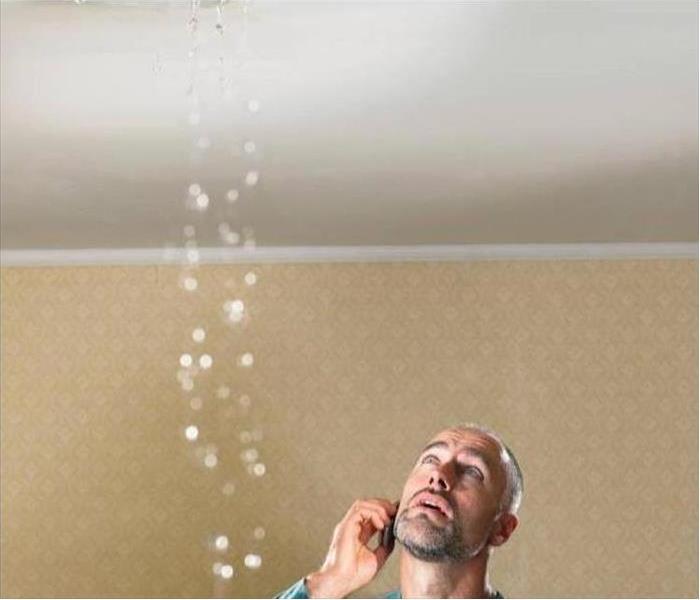 Let SERVPRO of Hacienda Heights/Rowland Heights repair your home after the rain.
Let SERVPRO of Hacienda Heights/Rowland Heights repair your home after the rain.
It may be nice and sunny this week but we should hopefully expect some more rain soon. SERVPRO of Hacienda Heights wants to make sure you take the time to prepare before the rain comes down and you are left with leaky roofs and water intrusion in your home.
Here are some tips you should consider to prevent future roof leaks:
1. Have an annual roof inspection.
2. Repair any cracks, gaps or damaged roof shingles right away.
3. If water intrusion does happen from your roof, make sure to have plenty of buckets to catch the excess water to prevent further damage to your home.
4. Ahead of time, find a local roofer that does emergency roof tarp service and keep their contact information for emergencies.
With any roof leak, contact SERVPRO of Hacienda Heights & Rowland Heights for 24-Hr Emergency Service! (909) 598-8400.
Visit:
www.SERVPROhaciendaheights.com
Tips from the Red Cross for Spring Weather
6/12/2019 (Permalink)
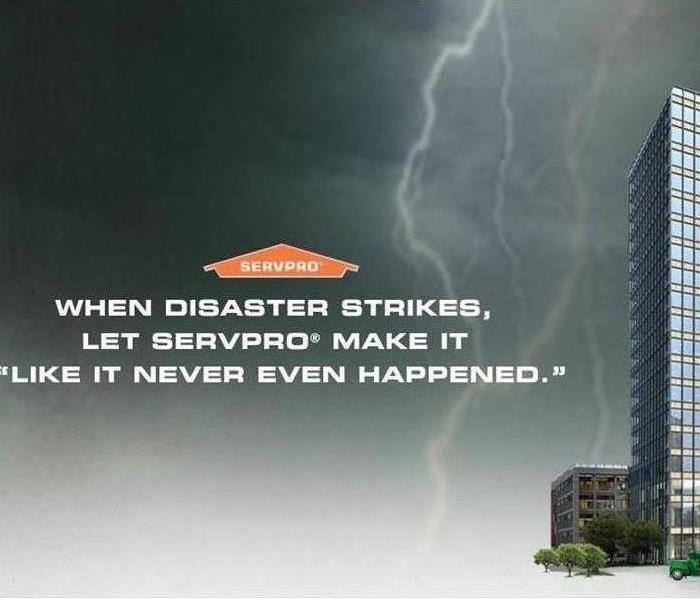 Chose SERVPRO of Hacienda Heights/Rowland Heights to repair your storm damage.
Chose SERVPRO of Hacienda Heights/Rowland Heights to repair your storm damage.
Spring can sometimes bring some severe weather, which can mean heavy rain, flash flooding, damaging winds and tornadoes. The American Red Cross Offers safety steps to follow if you area is affected.
Follow these Life Saving Safety Tips:
Thunderstorm Safety Steps; Thunderstorms injure an average of 300 people every year and cause about 80 fatalities. Here are the top thunderstorm safety steps you should follow.
- If you can hear thunder, you are close enough to the storm to be struck by lightning. Go to a safe shelter immediately.
- As the storm approaches, take shelter in a building.
- If you are driving, pull off the roadway and park. Stay in the car with the windows closed and turn on the emergency flashers. Avoid touching metal or other surfaces that conduct electricity in and outside of the vehicle.
- If you are inside, unplug appliances and avoid using the telephone or any electrical appliances. Avoid taking a bath or shower, or running water for any other purpose.
- If you are caught outside and cannot each a safe building, avoid high ground, water, tall, isolated trees and metal objects such as fences or bleachers. Picnic shelters, dugouts and sheds are not safe.
Flooding; Heavy rains could fill rivers and streams, bringing flooding to the area. If your neighborhood is threatened with the possibility of flooding, here are some things you should do.
- Be prepared to evacuate at a moment's notice. When a flood or flash flood warning is issued by your area, head for higher ground and stay there.
- Stay away from flood waters.
- If you come upon a flooded road while driving, turn around and go another way. If you are caught on a flooded road and waters are rising rapidly around you, get out of there quickly and move to higher ground. Most cars can be swept away by less than two feet of moving water.
- Keep children out of the water.
- Be especially cautious at night when it is harder to recognize flood danger.
If you would like to learn more about how to stay safe during a storm Visit the Red Cross Website: http://www.redcross.org/
Is A Storm Coming?
6/22/2018 (Permalink)
If one is, you should always be prepared. Although violent storms can strike anytime, the spring and summer months typically mark an increase in the threat of sudden, severe storms that sometimes include wind, rain, lighting and even hail.
Authorities issue a storm 'watch when the potential for severe weather exists. A storm 'warning' will be issued when danger from a severe storm is imminent. The following tips will help prepare you to better protect yourself and your property when a storm is on the horizon.
- Put a communication plan in place and prepare an emergency supply kit, including a battery-powered NOAA weather radio.
- Postpone outdoor activities; secure outdoor objects that could become airborne.
- Don't use corded phones or any appliances that are "plugged in." Use cell or cordless phones instead.
- Seek shelter in a home, building or hard top automobile. The steel frame of a vehicle (not the rubber ties) can help protect you from a lightning strike if you avoid touching metal or other conductive surfaces.
- Avoid windows and doors, don't lie on concrete walls, and stay off of porches.
- If you are outside when a storm hits, quickly seek shelter in a sturdy building. Avoid small, isolated structures in open areas and steer clear of hilltops, open fields, the beach or a boat on the water.
After A Storm
- Avoid storm-damaged areas. Stay away from downed power lines and never try to drive through a flooded roadway.
- Replenish your emergency supplies and repair property damage promptly, before the next storm strikes.
A Flooding Can Affect Anywhere
6/15/2018 (Permalink)
According to The National Weather Service (NOAA), "According seventy-five percent of all presidential disaster declarations are associated with flooding" NOAA lists the most common flood hazards in the United States as:
- Flash Flooding
- River Flooding
- Storm Surge and Coastal inundation from tropical and non-tropical systems
- Burn scars/debris flows (caused by wildfires)
- Ice/debris jams
- Snow-melt
- Dry wash (caused by heavy rainfall in dry areas)
- Dam breaks/levee failure
Just because you haven’t experienced a flood doesn't mean you won't in the future. In fact, 20% of all claims paid by The National Flood Insurance Program (NFIP) were for polices in low-risk communities. On average, floods cost $3.5 billion in annual losses in the U.S and commercial flood claims average more than $75,000.
It is always best to be prepared for any scenario of a disaster that may come whether it is Floods, Rain Storms, and Flash Flooding. SERVPRO of Hacienda Heights & Rowland Heights is always here to help!
Be Prepared For Any Storm
6/15/2018 (Permalink)
Serious weather can happen anytime, anywhere. Each year Americans will endure an average of the following fierce storms:
- 10,000 severe thunderstorms
- 5,000 floods or flash floods
- 1,000 tornadoes
- 2 land-falling deadly hurricanes
Approximately 98% of all presidential declared disasters are weather-related, leading to around 500 deaths per year and nearly $15 billion in damage. Knowing your risk of severe weather, taking action and being an example are just a few steps you take to be better prepared to save your life and assist in saving the lives of others.
- Know Your Risk: The first step to becoming weather-ready is to understand the type of hazardous weather that can affect where you live and work, and how the weather could impact you, your business and your family. Check the weather forecast regularly, obtain a NOAA weather radio, and learn about Wireless Emergency Alerts. Severe weather comes in many forms and your shelter plan should include all types of local hazards.
- Take Action: Take the next step in severe weather preparedness by creating a communications plan for your home and business. Put together or purchase an emergency kit. Keep important papers and valuables in a safe place.
- Be an Example: Once you have taken action to prepare for severe weather, share your story with co-workers, family and friends on Facebook, Twitter or Instagram. Your preparedness story will inspire others to do the same.
Examples of items that should be in your Supply Kit:
-Water (one gallon per person, per day)
-Food (non-perishable 3-day supply)
-Manual can opener
-Battery operated radio, preferable a NOAA weather radio
-Flashlight and extra batteries
-First Aid Kit
-Whistle to signal for help
Please visit http://www.redcross.org to see more items that are essentially necessary and how to create your Supply Kit!
What if your residential or commercial property sustains flood damage?
6/12/2018 (Permalink)
It’s tragic when a flood brings devastation and water damage to your home. But rapid water removal, clean up and repairs certainly must get under way for your home to get back to normal with minimal losses. Safety is a top priority. After the flood damage, evaluation of the home's safety issues must be completed before you dare to enter your home again.
In times like this is when it's best to call your insurance company or agent to ascertain if you are covered under your standard home owner's policy or if you do possess flood insurance. An insurance adjuster will be dispatched to your property to inspect the damage and eventually offer a settlement. Ask for help in retaining a competent water damage restoration company like SERVPRO of Hacienda Heights & Rowland Heights. We can assess and document all water damaged items, help you with your claims and paperwork, and expedite the water removal and restoration. We can check your home for structural damage and any possible electrical issues since water and electricity are a dangerous duo. This inspection will indicate to you the severity of the water damage that your home has suffered and any potential health issues you may have to address during the process of getting the flood damage repairs done on your home.
Once you have done the documentation and the adjuster has done his inspection, then the clean up starts to get under way. The home needs to be made dry and needs to be cleaned up as soon as possible to prevent any other damage from occurring. This will also lessen the likelihood of mold and mildew growth. Contamination is given if the flooding is the result of groundwater intrusion, whether from rain, bodies of water, or a sewage blockage. Do not attempt to clean and sanitize on your own. The potential for future illness is too great.
It's wise to call the professionals from SERVPRO of Hacienda Heights & Rowland Heights; because we can immediately begin to pump out the water and mitigate on-going water damage, and they have the skill and knowledge. Along with the professional equipment required to start and complete the entire restoration process for you.
Be Sure to Clean Your Gutters!
6/12/2018 (Permalink)
During long summer days, it's easy to forget that there is always a possibility of a downpour! Air conditioning maintenance and Air Duct cleaning are essential for any home. Do not neglect the outside, summer rains can bring high damaging winds that dislodge branches from trees which may look to find a new home on top of yours. So, it's definitely essential after any storm to inspect your rain gutters, all you would need is a ladder, gloves, protective goggles, a water hose and a scoop.
There are 3 easy steps to clean your gutters:
- Use a ladder to reach your gutters and begin to scoop, start from the end closest to the drain outlet. For faster cleanup in the end, toss the offending material into a bucket on the ground.
- With a water hose in tow, spray a steady stream of water through the gutters towards the drain outlet. This is much easier using a hose with a pressure gauge for high and low power, but any will work just as well.
- Make sure to check your drain pipes for any blockages. Hopefully any potential blocks are minimized by scooping out the debris before it makes it into the pipes. However, there are instances where the rain storms forced material into the pipes. If you see a trickle instead of a flow coming from your pipes, use the hose at the top of the gutter and spray directly into the outlet. For harder to reach items, try a plumber's snake.
For more tips for your home visit: hometips.com
Does Your Family Have an Emergency Plan?
6/12/2018 (Permalink)
Developing a Family Emergency Plan Before a catastrophic event is crucial in making sure your family is safe. We at SERVPRO of Hacienda Heights & Rowland Heights realize this and love to help!
Is My Family Prepared?
That is the first question you need to ask to keep your family safe. If the answer is yes, you are a step ahead. If the answer is no, then follow the steps below to ensure the safety of your family!
- Sit down as a family and decide how each person will be contacted, where you will meet, and where you will evacuate if instructed by officials. The Information below will help you fill out your Family Emergency Plan.
- Record your out-of-town contact if your family is separated.
- Choose a family meeting place right outside your home in case of a sudden emergency, like a fire. Choose a regional location in case family members are not together.
- Put together your Disaster Supply Kit. This will include the basics like, food, water, and first aid to last your family for 3 days, and include some activities for children such as books or deck of playing cards.
For more information feel free to Visit: http://kidsgetaplan.com/
Here is Some Tips from the Red Cross for Spring Weather
6/12/2018 (Permalink)
Spring can sometimes bring some severe weather, which can mean heavy rain, flash flooding, damaging winds and tornadoes. The American Red Cross Offers safety steps to follow if you area is affected.
Follow These Lifesaving Safety Steps:
Thunderstorm Safety Steps; Thunderstorms injure an average of 300 people every year and cause about 80 fatalities. Here are the top thunderstorm safety steps you should follow.
- If you can hear thunder, you are close enough to the storm to be struck by lightning. Go to a safe shelter immediately.
- As the storm approaches, take shelter in a building.
- If you are driving, pull off the roadway and park. Stay in the car with the windows closed and turn on the emergency flashers. Avoid touching metal or other surfaces that conduct electricity in and outside of the vehicle.
- If you are inside, unplug appliances and avoid using the telephone or any electrical appliances. Avoid taking a bath or shower, or running water for any other purpose.
- If you are caught outside and cannot each a safe building, avoid high ground, water, tall, isolated trees and metal objects such as fences or bleachers. Picnic shelters, dugouts and sheds are not safe.
Flooding; Heavy rains could fill rivers and streams, bringing flooding to the area. If your neighborhood is threatened with the possibility of flooding, here are some things you should do.
- Be prepared to evacuate at a moment's notice. When a flood or flash flood warning is issued by your area, head for higher ground and stay there.
- Stay away from flood waters.
- If you come upon a flooded road while driving, turn around and go another way. If you are caught on a flooded road and waters are rising rapidly around you, get out of there quickly and move to higher ground. Most cars can be swept away by less than two feet of moving water.
- Keep children out of the water.
- Be especially cautious at night when it is harder to recognize flood danger.
If you would like to learn more about how to stay safe during a storm Visit the Red Cross Website: http://www.redcross.org/
Flood Safety Tips
2/16/2018 (Permalink)
Ready is a perfect resource to assist with any weathers disaster tips.
Flooding is a temporary overflowing of water onto the land that is normally dry. Flooding may happen with only a few inches of water, or it may cover a house to the rooftop. There are many possible causes of floods including heavy rain or snowmelt, coastal storms and storm surge, waterway overflow from being blocked with debris or ice, or overflows of levees, dams, or waste water systems, flooding can occur slowly over many days or happen very quickly with little or no warning, called flash floods.
Basic Safety Tips:
- Avoid walking or driving through flood water.
- Do not drive over ridges that are over fast-moving floodwaters. Floodwaters can scour foundation material from around the footings and make the bridge unstable.
- Just 6 inches of moving water can knock you down, and one foot of moving water can sweep your vehicle away.
- If there is a chance of flash flooding, move immediately to higher ground.
- If floodwaters rise around your car but the water is not moving, abandon the car and move to higher ground. Do not leave the car and enter moving water.
- Avoid camping or parking along streams, rivers, and creeks during heavy rainfall. These areas can flood quickly and with little warning.
After a Flood:
- Return home only when authorities say it is safe.
- Be aware of areas where floodwaters have receded and watch out for debris. Floodwaters often erode roads and walkways.
- Do not attempt to drive through areas that are still flooded.
- Avoid standing water as it may be electrically charges from underground or drowned power lines.
- Photograph damage to your property for insurance purposes.
SERVPRO can quickly protect your home after a Storm
7/27/2017 (Permalink)
Following a storm flood or fire, water cleanup in Hacienda Heights, California is the first and one of the most important processes that you will need to have done. In the event that you don't complete the water removal process immediately, your property can be subjected to a plethora of unwanted, unnecessary complications such as mold growth, loss of possessions, and structural damage. If you find yourself in need of water damage services, it's important to find a skilled team of restoration experts like SERVPRO of Hacienda Heights and Rowland Heights. We can expedite the water extraction, cleaning, repair, and restoration components of the process.
- Water cleanup prevents Mold and Mildew growth: One of the reasons for securing the services of an experienced water damage cleanup company is inhibiting the growth of mold and mildew in your home. Unfortunately, these fungi can begin thriving and expanding on your property 48-72 hours after the initial water intrusion. Moreover, the moist, warm conditions created by water damage make your residential property a prime location in which mold can develop and proliferate.
- Prevent or Diminish Secondary Water Damage to the structure of your home: Another great benefit of rapid water removal is that it prevents structural damage from adversely impacting your property. When left unaddressed for an extended time, the water can wick into walls, and studs, rust appliances, and damage the electrical system. If a natural flooding disaster occurred, then the foundation could also have been compromised.
Always be sure to clean your gutters
6/6/2017 (Permalink)
During long summer days, it is easy to forget that there is always a possibility of a downpour! Air conditioning maintenance and Air Duct cleaning are essential for any home. Do not neglect the outside, summer rains can bring high damaging winds that dislodge branches from trees which may look to find a new home on top of yours. So, it is definitely essential after any storm to inspect your rain gutters, all you would need is a ladder, gloves, protective goggles, a water hose and a scoop.
There are 3 easy steps to clean your gutters:
- Use a ladder to reach your gutters and begin to scoop, start from the end closest to the drain outlet. For faster cleanup in the end, toss the offending material into a bucket on the ground.
- With a water hose in tow, spray a steady stream of water through the gutters towards the drain outlet. This is much easier using a hose with a pressure gauge for high and low power, but any will work just as well.
- Make sure to check your drainpipes for any blockages. Hopefully any potential blocks are minimized by scooping out the debris before it makes it into the pipes. However, there are instances where the rain storms forced material into the pipes. If you see a trickle instead of a flow coming from your pipes, use the hose at the top of the gutter and spray directly into the outlet. For harder to reach items, try a plumber's snake.
For more tips for your home visit: hometips.com
El Niño: We Are Ready!
1/7/2016 (Permalink)
El Niño is here! And we have only seen the beginning of the storms. SERVPRO of Walnut/ Hacienda Heights & Rowland Heights has the resources to assist residential and commercial properties with roof leaks and flooding. Contact us for 24-Emergency Service!
April Showers Bring May Flowers
4/16/2014 (Permalink)
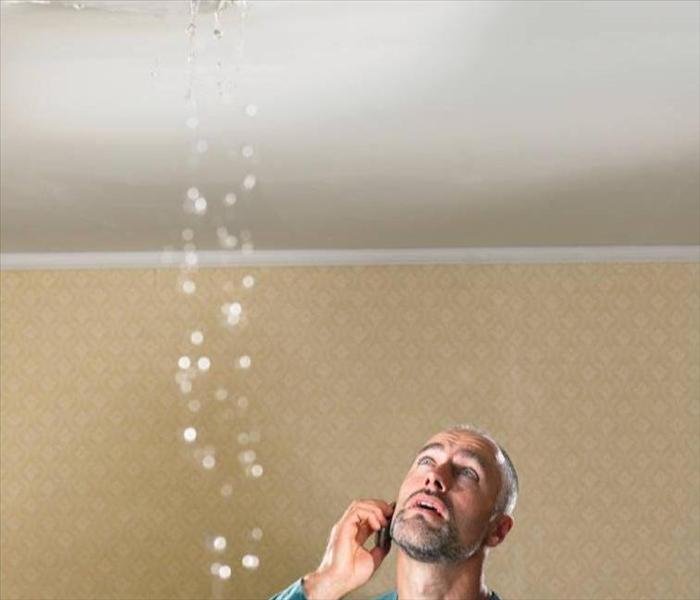 Roof Leak
Roof Leak
It may be nice and sunny this week but we should hopefully expect some more rain soon. SERVPRO of Walnut & Hacienda Heights wants to make sure you take the time to prepare before the rain comes down and you are left with leaky roofs and water intrusion in your home.
Here are some tips you should consider to prevent future roof leaks:
1. Have an annual roof inspection.
2. Repair any cracks, gaps or damaged roof shingles right away.
3. If water intrusion does happen from your roof, make sure to have plenty of buckets to catch the excess water to prevent further damage to your home.
4. Ahead of time, find a local roofer that does emergency roof tarp service and keep their contact information for emergencies.
With any roof leak, contact SERVPRO of Walnut/ Hacienda Heights & Rowland Heights for 24-Hr Emergency Service! (909) 598-8400.
Visit:
www.SERVPROwalnut.com
www.SERVPROhaciendaheights.com
(909) 598-8400





 24/7 Emergency Service
24/7 Emergency Service



























